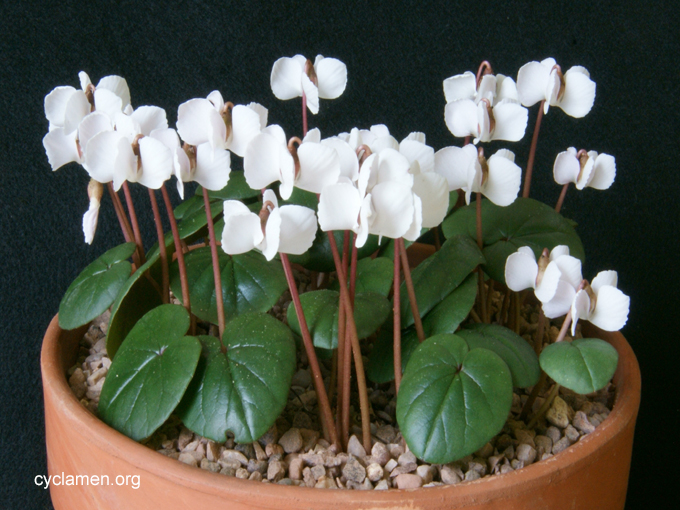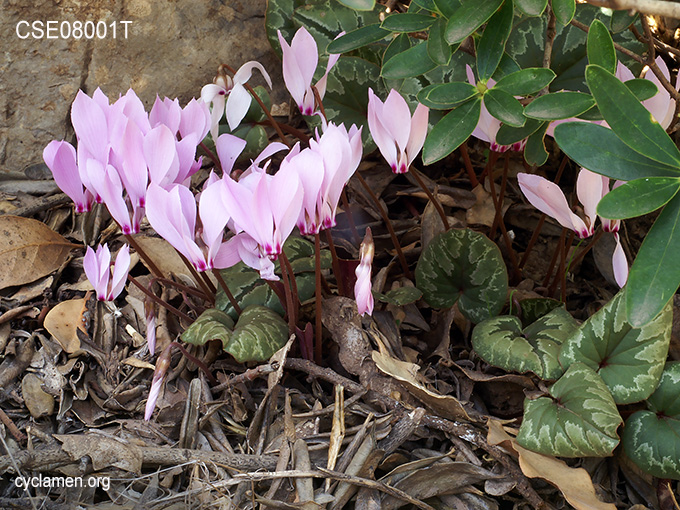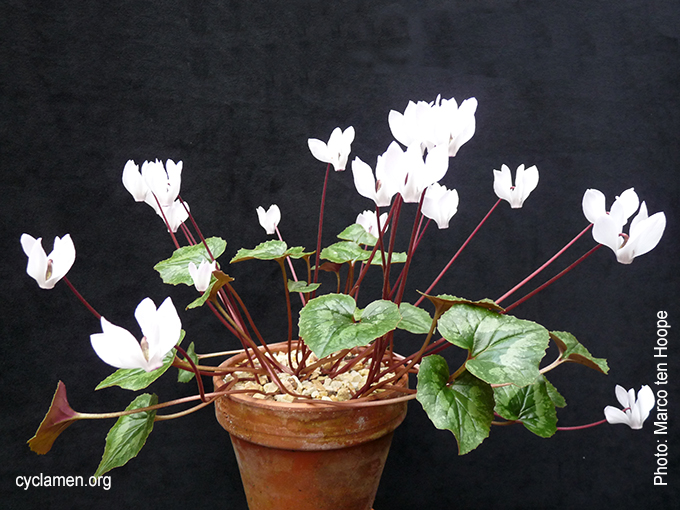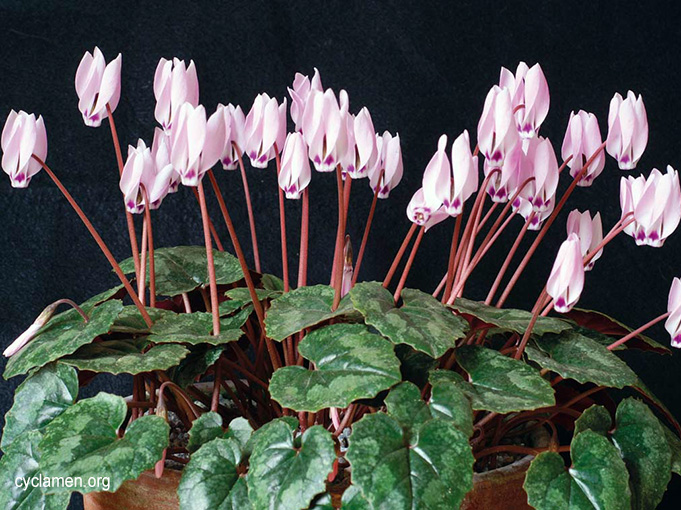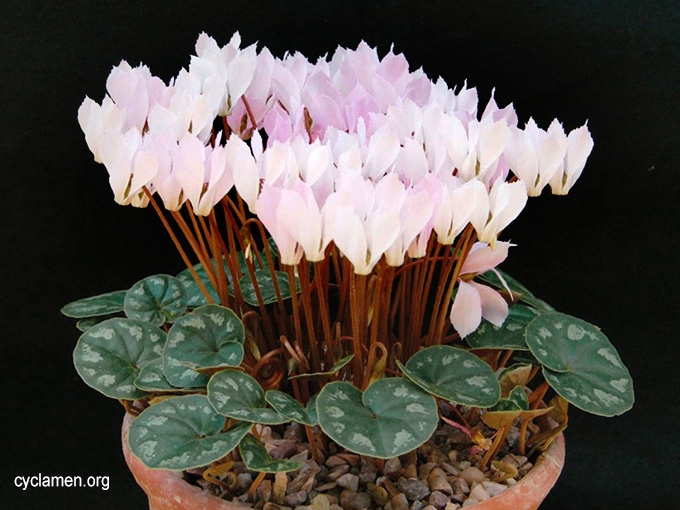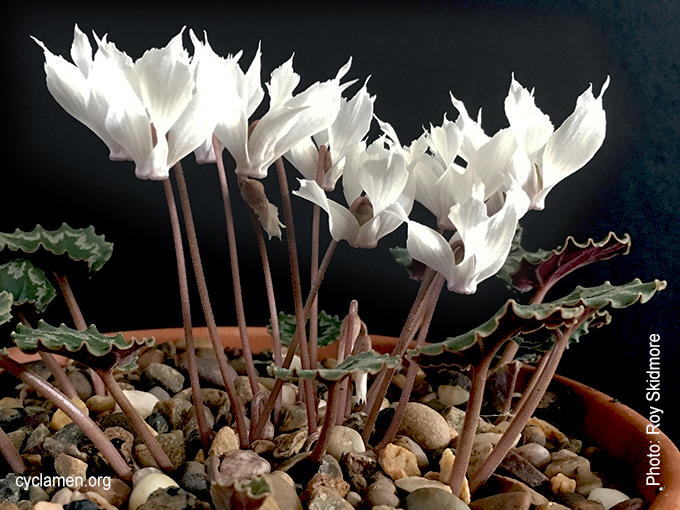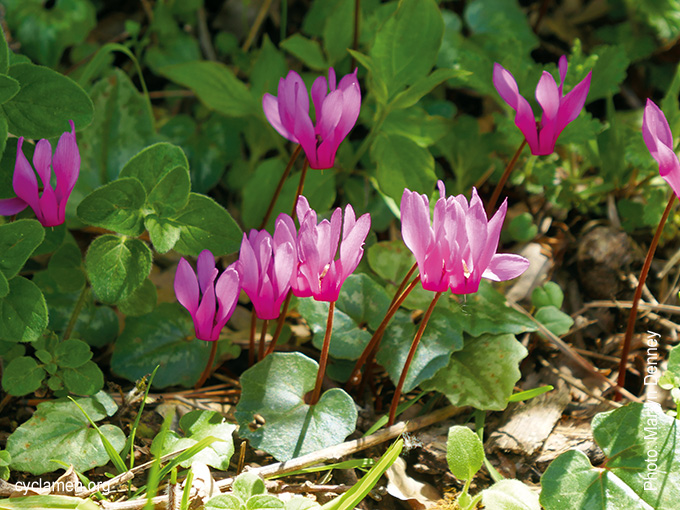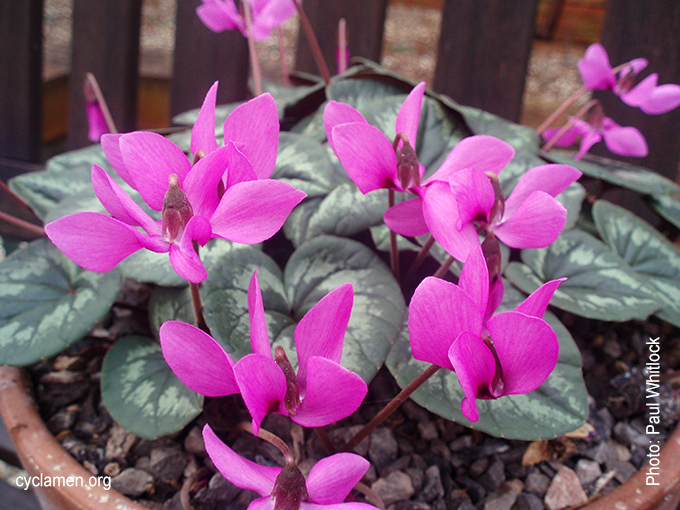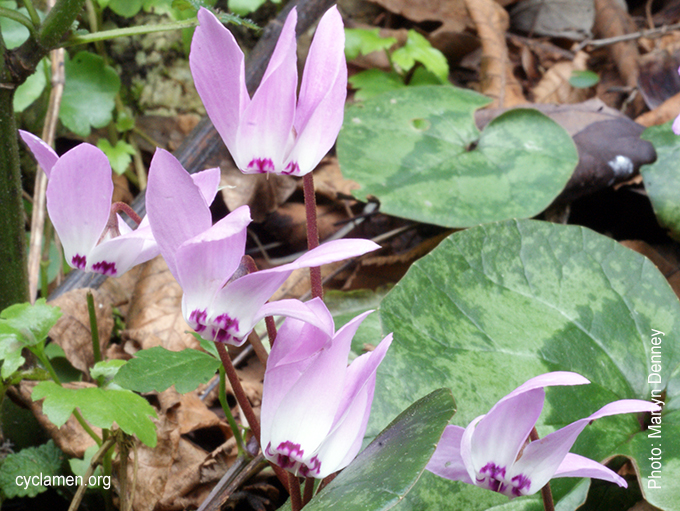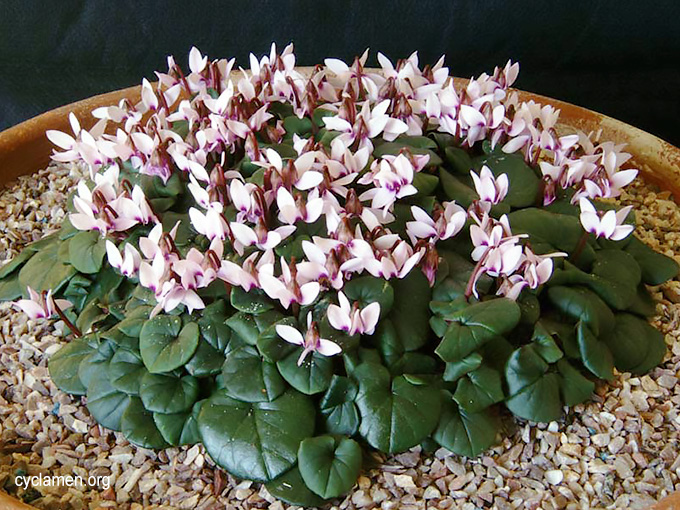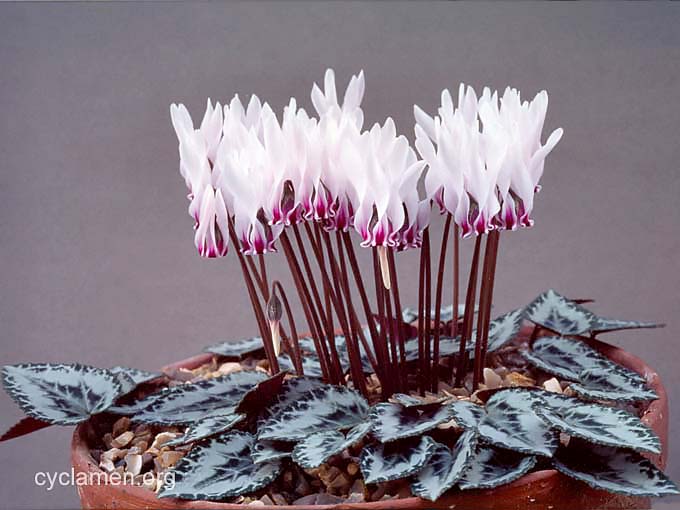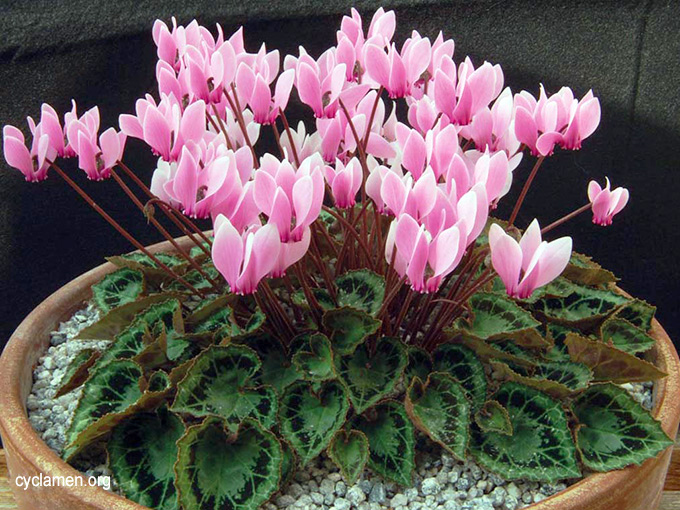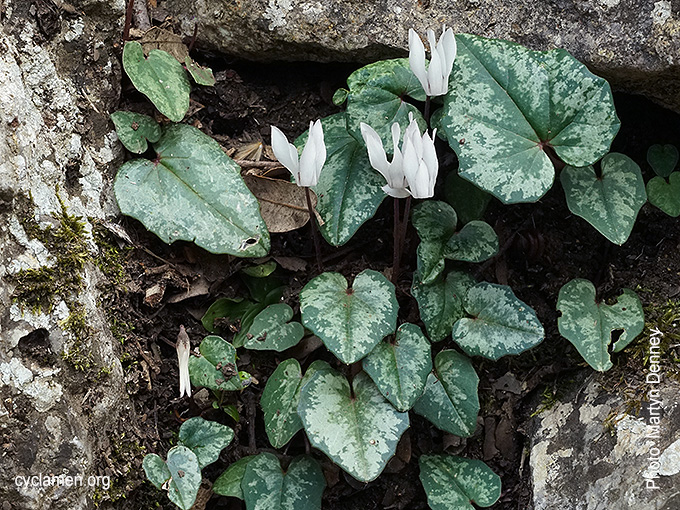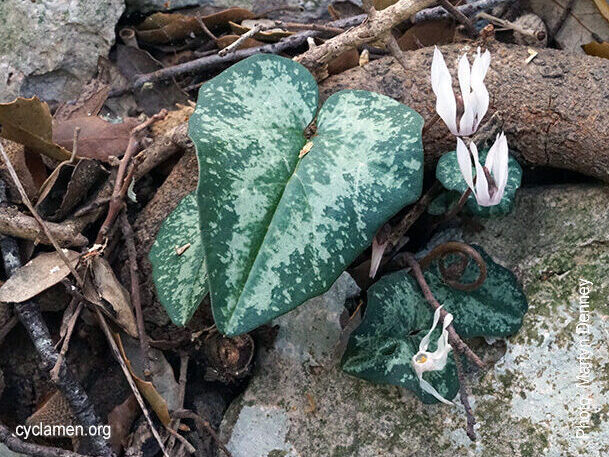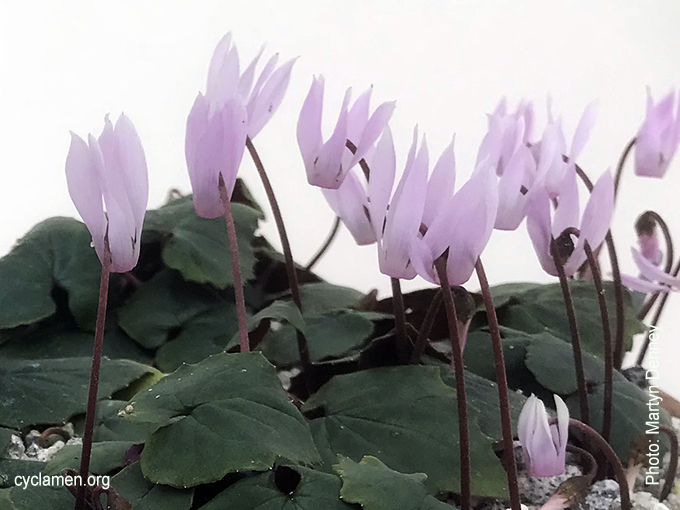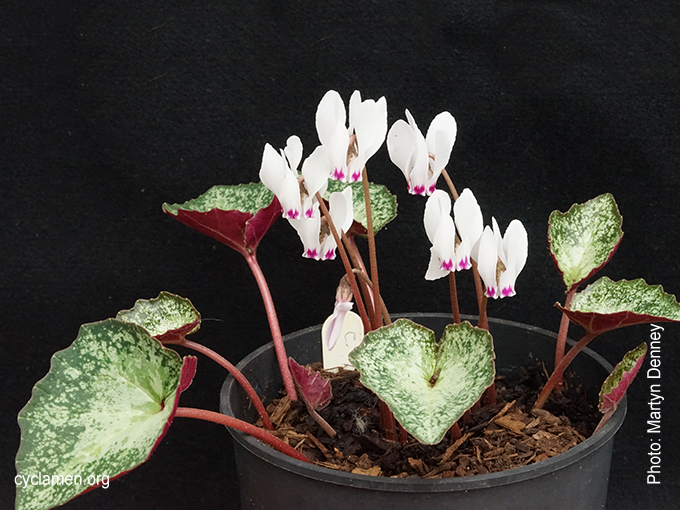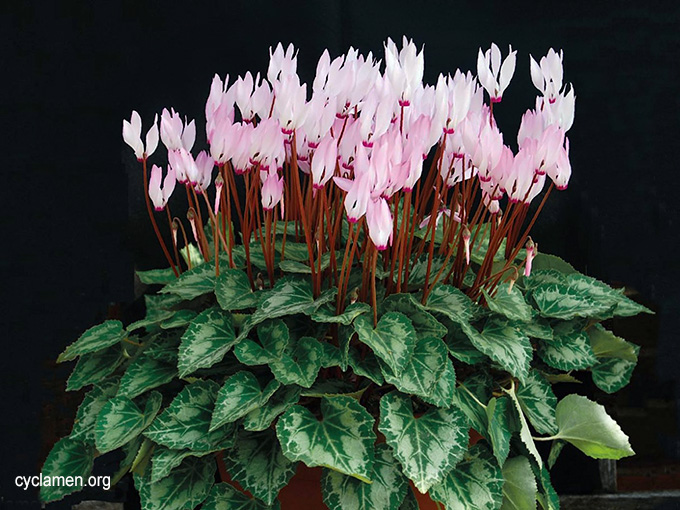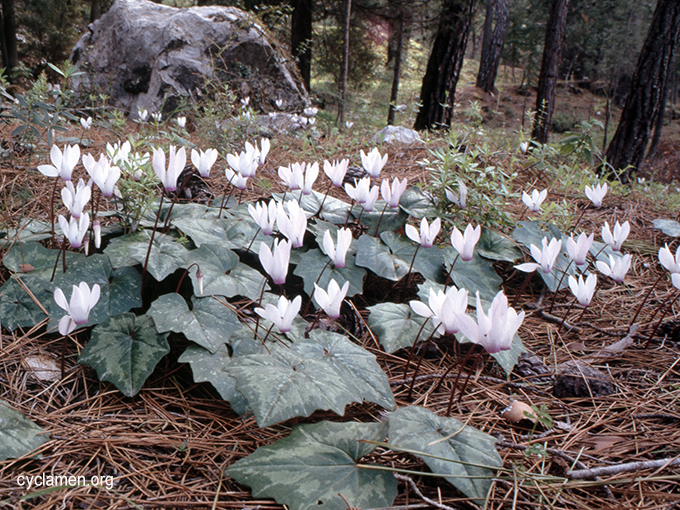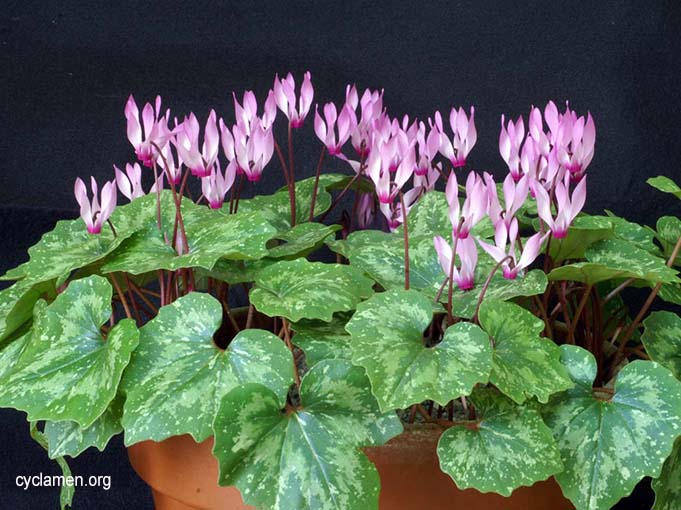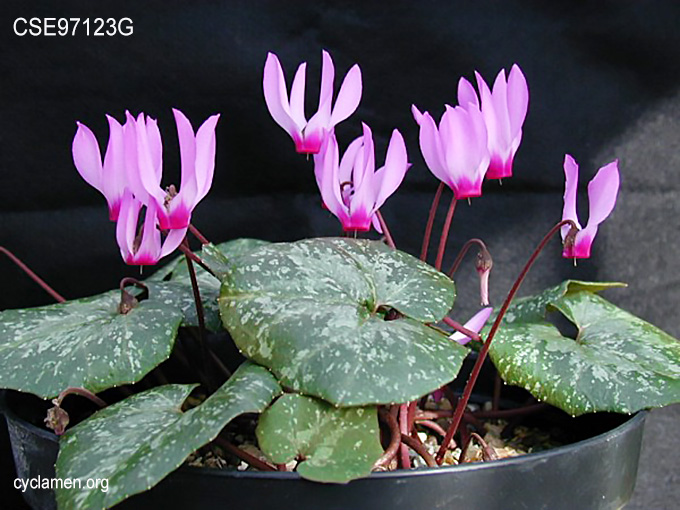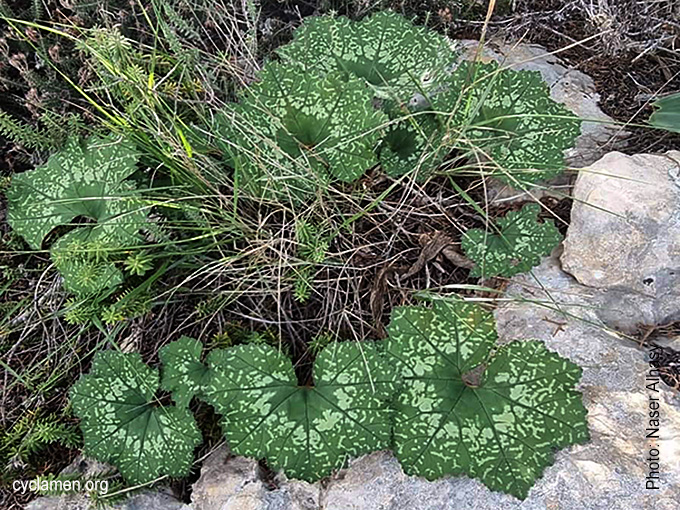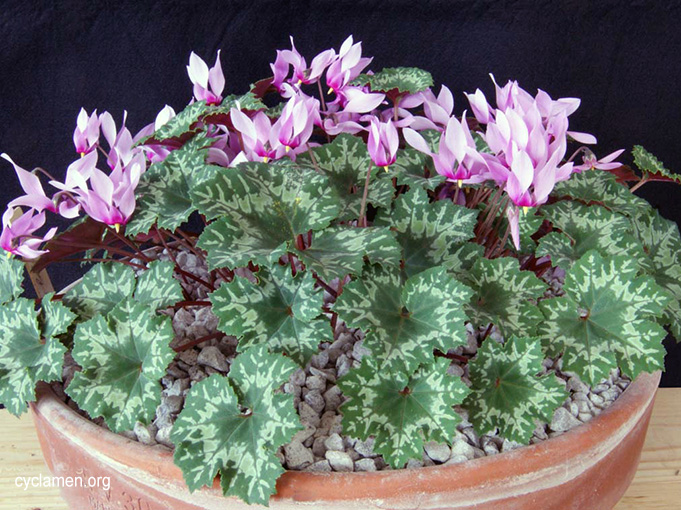Hardy Species for the Garden
Hardy Species for Cold Glass
Tender Species
The Cyclamen Species
There are currently 24 species of cyclamen. Some of them make excellent plants for the open garden. They will flower consistently over a long period, need no regular maintenance, and will seed about if left to their own devices.
The soil usually recommended is well-drained loam with a good organic content, but many gardeners find that the hardier species grow equally easy in heavy clay soils. These will tolerate a wide range of situations, from deep shade to full sun, but others do better with some shade during the hotter parts of the day.
Recommendations are given in the individual species list. Cyclamen hederifolium can be very vigorous, so it is best not to interplant other species with it.
Hardiness is a controversial topic. In cold, exposed gardens only the hardiest species will grow, but in warmer more sheltered gardens with well drained soils those grown under glass elsewhere may flourish and seed about. Cyclamen can be grown in alkaline and acidic soils with equal ease. The planting depth is not critical. About 2 cm (¾ in) deep will suit most, although 5 cm (2 in) is recommended for C. repandum, C. rhodium and their allies. In cold areas up to 15 cm (6 in) is better.
With the exception of the evergreen C. purpurascens and C. colchicum, all species will have a dormant period during the summer; if the leaves die off in May or June, do not despair: growth will begin again in the autumn.
All cyclamen can be grown as pot plants in a greenhouse or cold frame.
They need good ventilation throughout the year, shade in summer, and the less hardy ones need protection from frost in winter. During the growing season, the compost should be kept damp but not wet, and during the dormant period it should be kept just moist. Overwatering may be fatal!
For conservation reasons the Cyclamen Society does not condone the purchase of dry tubers that have been dug from the wild. Although the prices are often low, they are usually very dried out, and can be very difficult to establish. This makes them a very poor bargain.
Cyclamen are best bought as growing plants in pots which are easy to establish rather than as dormant tubers, and are mostly grown from seed in Britain. The life expectancy of individual tubers once established varies from 20 to I00 years, making them wonderful value.
Cyclamen names
While the names of most species have been very stable, there have been some recent changes, so you may not find some of the names in this guide in earlier reference books. Earlier names are listed below, with the current name in bold.
C. alpinum
C. confusum
C. hederifolium
C. maritimum
C. purpurascens
C. rhodium subsp. peloponnesiacum
C. rhodium subsp. rhodium
C. rhodium subsp. vividum
C. trochopteranthum
C. hederifolium subsp. confusum
C. neapolitanum
C. graecum subsp. anatolicum
C. europaeum
C. repandum subsp. peloponnesiacum
C. repandum subsp. rhodense or C. rhodium
C. repandum subsp. vividum or C. repandum subsp. peloponnesiacum var. vividum
Hardy Species for the Garden
All of the species listed below are hardy to at least -I0°C (l4° F) but they cope better with lower temperatures where they are not also saturated with water. This can be helped in colder areas by planting at the base of trees or shrubs and/or placing the tubers deeper in the soil. Left to their own devices they will seed themselves around and are good subjects for mass planting.
A number of other species are also hardy but are less readily available and are generally grown under glass where they can be better cared for. These are dealt with in the next section.
In each section below the species are arranged roughly in order of ease of cultivation.
Cyclamen hederifolium
Known as the ivy leaved cyclamen. It is widely distributed through Switzerland, ltally, the Balkans and Greece to western Turkey and shows an amazing range of variation in leaf shape and pattern. It is very tolerant of poor, dry soils and will flourish in full sun or deep shade. Tubers can be very long lived; they may reach one hundred years old and exceed 30cm (12 in) in diameter. The flowers emerge from July to October. The leaves follow, and carpet the ground until May or June. Flowers range from deep pink to white, white-flowered ones are often more vigorous plants in the garden.
Cyclamen coum
Growing in Romania, Bulgaria, Turkey, the Levant, the Caucasus and the Crimea. This is a winter gem, flowering from late December to the end of March. The kidney or heart shaped leaves vary from plain green through pewter to silver, or some combination of these. The flowers range from magenta through pink to white. The flowers are unaffected by frost or snow and a planting of mixed forms is very effective.
Cyclamen purpurascens
This and C. colchicum are the only evergreen species. It grows mainly in deciduous woodlands from eastern France to Slovakia. In the garden, a good, humus-rich soil which does not dry out completely in summer and shade during the hottest part of the day is the recipe for success. It does well planted amongst rhododendrons or other small shrubs and is worth any amount of trouble to find the right situation for the flowers have a wonderful strong and sweet scent. The flowers are produced from June to September and sometimes much later.
Cyclamen cilicium
From the Taurus Mountains in southern Turkey, this flourishes in sunny, well-drained positions. The pink flowers, produced September to October have a honey scent. As the two species have similar growth rates, it can be interplanted with C. coum to give two seasons of flower from the same spot. Many growers find that the form with pure white flowers is slightly more vigorous.
Cyclamen confusum
Superficially, this looks like a form of C. hederifolium with thicker, shinier, leathery leaves. It comes only from north western Crete, where it grows under pines or in gorges. The flowers appear from October to November and are often larger than those of its relative and have a strong, sweet scent. It is also very tolerant of dry situations. Only described as a distinct species in 2009, this is scarce, but well worth seeking out.
Hardy species for cold glass
The species below are also hardy, but scarcer and more expensive, so are usually grown in a cold greenhouse or cold frame.
Cyclamen pseudibericum
The small range of distribution is centred on the Amanus and adjacent Anti-Taurus Mountains in southern Turkey. Though less readily available than the species in the previous section, this promises to be a wonderful garden plant when it becomes more readily available. The flowers, borne from March to May vary from pink to magenta, and have a distinctive spicy, peppery scent. A situation similar to that recommended for C. purpurascens is ideal though it tolerates more sun.
Cyclamen intaminatum
If you like miniature plants, this is the one for you. It comes from a small area of northwest Turkey and flowers in September and October. Although fully hardy, because of its small size it is best grown in a raised bed, trough or pot. The flowers are white or pale pink with indistinct grey lines, and the leaves almost circular, either plain green or patterned. Some plants have flowers that open pale pink but become white as they age. It grows well in sunny situations, or in dappled shade and is an attractive plant for a pot in a cold greenhouse too.
Cyclamen mirabile
Found in south-western Turkey, this closely resembles C. cilicium, but the tips of the petals are serrated, and the honey scent is ‘heavier’. It flowers from September to October. In selected forms, the young leaves emerging in autumn are flushed with a beetroot colour on the upper surface. This fades as the leaves age. This is definitely a plant for cooler, shadier situations, in humus-rich soils. Good drainage is essential. It associates well with C. purpurascens. The white-flowered forms are less vigorous, and best cosseted in a pot.
Cyclamen alpinum
Formerly called C. trochopteranthum, it is found in south-west Turkey and is unique in that the petals stand out horizontally, making the flowers look much like propellers. The honey scent is similar to that of C. cilicium, but this is a winter-flowerer, at its best in February and March. It needs the same conditions as C. mirabile. White flowered forms are rare and choice, and best grown in a pot.
Cyclamen repandum
Found mainly in Italy, Sicily, Corsica, Sardinia and along the Adriatic coast of the Balkans, this is a woodland plant. In the garden it needs shade from hot sun, and protection from wind. Under trees, or between smaller shrubs are ideal locations. The violet scented flowers are typically carmine, often with a darker nose, and appear in April and May. It establishes best if growing tubers are planted as soon as the leaves shrivel in May or June, and will seed about in following years. Plant deeply (15 cm / 6 in). In colder climates it is safer in a cool glasshouse.
Cyclamen elegans
This native of northern Iran is related to C. coum, but differs in the taller, more elegant flowers (hence the name), and the leaves which are somewhat pointed. It flowers from December through to March depending on the season. The hardiness is not fully established, but some forms will tolerate -I0°C (I4° F) in well-drained soil. A superb pot plant, it is also worth trying in the garden in a sheltered, shady situation.
Cyclamen colchicum
A relative of C. purpurascens from the Caucasus. The leaves have a thick, leathery texture and toothed edges. The sweetly scented flowers appear from late July until September. Hardiness is not a problem, but a good deal of shade and moisture seems to be necessary to keep this plant flourishing. It is scarce in cultivation.
Cyclamen libanoticum
Only known from around a single mountain northeast of Beirut in Lebanon. As both leaves and flowers are large, this only succeeds in sheltered spots in the garden, but grows better in pots under glass or in a raised bed. The flowers, borne in late winter and have a musky or spicy scent.
Cyclamen parviflorum
The second miniature species is very hardy indeed, coming from high in the Pontus Mountains in northeast Turkey. It flowers from February to March. One of the main problems in cultivation is keeping it cool enough in summer. Too much water, especially during the warmer months can be rapidly fatal. During dormancy, a north facing cold frame is probably the ideal location. Not a plant for beginners.
Cyclamen graecum
There are two subspecies – graecum, and candicum. Recent experiments have shown this species to be much hardier than previously thought in a sunny well-drained position, but it performs better under glass. Subsp. candicum grows on Crete, but subsp. graecum is widely distributed in Greece, including many Aegean islands. The roots are very long, so a deep pot is an advantage. The leaves on many forms have a wonderful velvety texture. The pink or white flowers are produced from September to October. C. graecum subsp. candicum is the hardiest subspecies.
Cyclamen maritimum
Until recently considered a sub-species of C. graecum, this species from southern Turkey, the north of Rhodes and north west tip of Cyprus requires the same conditions as C. graecum and has similar long thick roots. The young leaves can often include shades of pale green and brown. It flowers in September and October.
Tender species
This group do best in a glasshouse, more-or-less frost free, although in favoured gardens, some can be grown in the open.
Cyclamen africanum
From Algeria and Tunisia. This is like a large leafed form of C. hederifolium, the leaves are thick and leathery and usually have small horny teeth at the edges. The best leaf forms are very decorative. The pink flowers produced September to November have a violet fragrance.
Cyclamen balearicum
Though named for its location on the Balearic Islands, it is also found in a few places in southwest France. It will withstand a few degrees of frost overnight, but not prolonged freezing. The leaves are small, dark green and variably marked with silvery blotches. The February to March flowers are white, with very faint pink or brown lines, and are strongly scented.
Cyclamen creticum
Endemic to Crete and the adjacent island of Karpathos, C. creticum flowers from February to April. The elegantly tapered flowers are usually pure white (rarely pale pink) and sweetly scented. The leaves are usually a rather deep grey green, and lightly to heavily splashed with bright silver. Deep planting in a pot and shade from bright sun is recommended.
Cyclamen cyprium
Another island species – endemic to Cyprus. The flowers appear from October to December, often just before the leaves. The usually pure white flowers have a deep pink marking at the base of each petal often likened to a bird in flight. They are strongly scented.
Cyclamen perslcum
This is the wild parent of the florists’ cultivars and has a wide distribution through Greece, Turkey, Syria, Israel, Lebanon and Tunisia. The flower colours range from white to deep pink and from lilac to deep purple; and the flowers mostly have a strong scent, reminiscent of Lily of the Valley.
The flowering period is from winter to spring (sometimes autumn). A hardier form has been introduced from Israel by the Cyclamen Society. It is often planted with the upper half of the tuber exposed.
Cyclamen rhodium
There are three subspecies, which flower in April – May.
C. rhodium subsp. rhodium is usually grown in a pot. It is found at lower altitudes on the island of Rhodes. The flowers are usually pure white, with a pale pink base, and the leaves vary from plain dark green (almost like ivy) to lightly splashed with silver.
C. rhodium subsp. peloponnesiacum from the central Peloponnese (Greece) will establish well in favoured gardens but needs a sheltered site, shade from hot sun and deep planting. It is well-worth cosseting in a pot though, because the leaves of the best forms are very beautiful, with a dense splashing of silver spots.
C. rhodium subsp. vividum from the eastern Peloponnese and the island of Kythera, is the hardiest, and will seed about in some gardens. Planting I0 – 20cm (4 – 8 in) deep increases the chance of success. It is however, safest in a pot. In the open garden, a sunny position sheltered from cold winds is best. In a pot, a planting depth of I0cm (4 in) is sufficient, and some shade should be given. The flowers are a vibrant shade of carmine.
Cyclamen rohlfsianum
The least hardy species. It grows in the limestone foot hills between Benghazi and Derna in Libya, and only grows well in a pot in a frost-free greenhouse or conservatory. The leaves may become very large, and can be beautifully patterned. The flowers are unique, as the anthers and style project in a cone, making them look like a Dodecatheon (American Shooting Star). The tubers can be kept completely dry from when the leaves die off (usually in May) until growth restarts (usually in September).
Cyclamen somalense
Discovered in the Al Miskat Mountains in northern Somalia in 1986, this species has not been established in cultivation.



